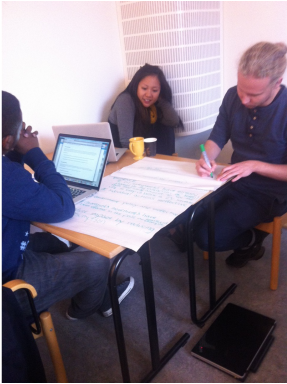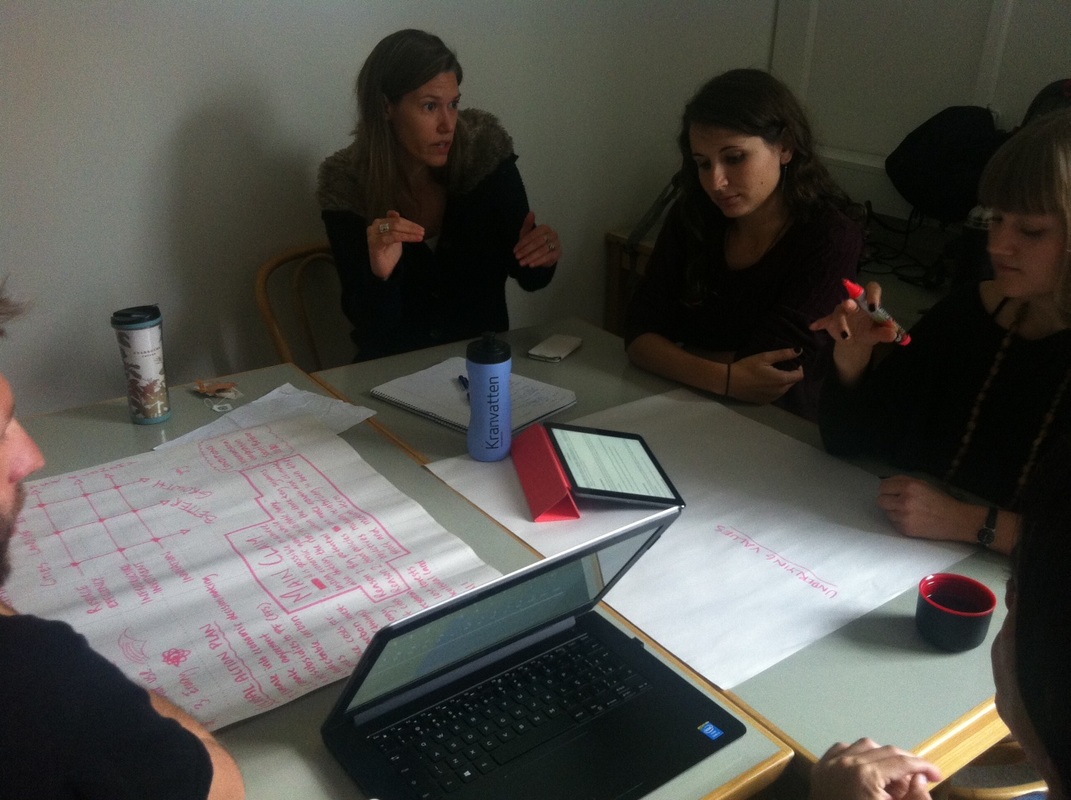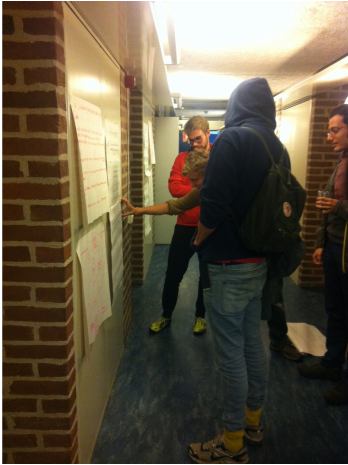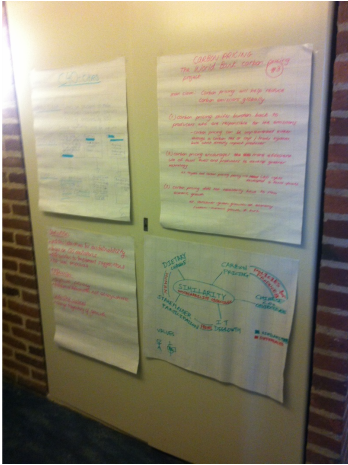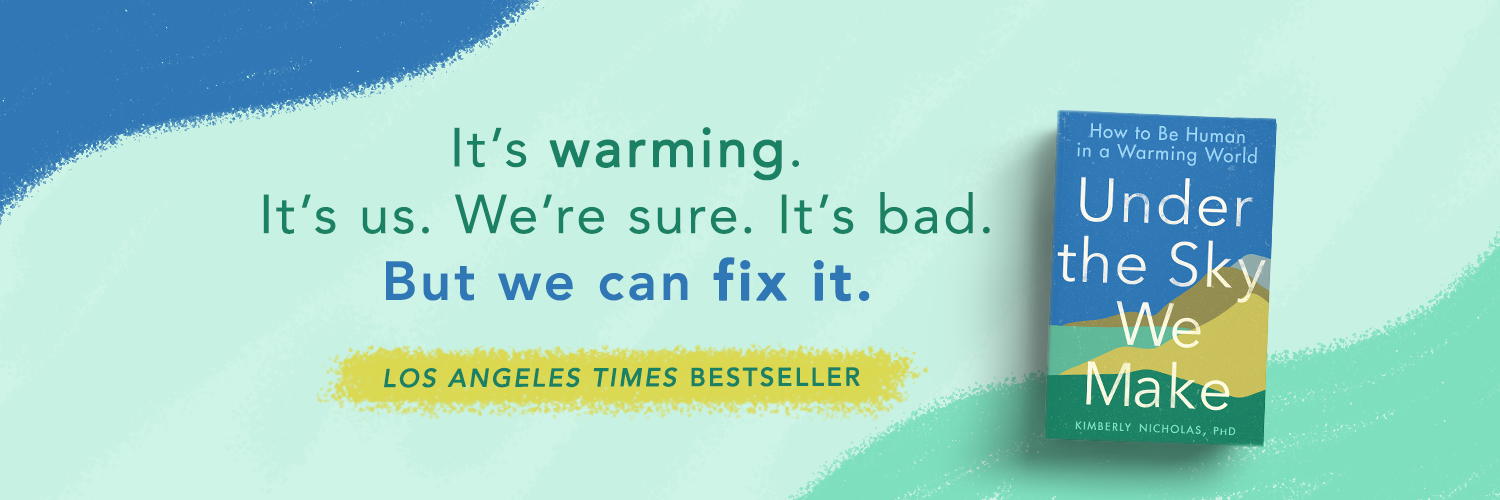Climate Change "We Can Fix It World Café" 2014
Welcome to the World Café 2014! This is an archive page- see the latest page here.
You can read a blog post describing the motivation for this activity here, or dive right in below.
Student or teacher feedback on the activity, or suggestions for additional solution resources, are welcome to @KA_Nicholas on Twitter.
You can read a blog post describing the motivation for this activity here, or dive right in below.
Student or teacher feedback on the activity, or suggestions for additional solution resources, are welcome to @KA_Nicholas on Twitter.
Preparation
Teacher Preparation
Student Preparation
- This activity is designed for a three-hour seminar (possible to modify for two hours by doing only parts 1 and 2 below, and skipping the poster session). I designed it for the LUMES master's program, but it should work for other levels of students as well.
- Select as many reports as needed so that there will be four students discussing each report (I used all 12 reports below for my class of 46 students, with 10 groups of 4 students and 2 groups of 3 students).
- Assign students (or have them sign up) to read one of the recent reports below, which offer different proposals for addressing climate change.
- Arrange classroom tables to seat groups of four, and give each table a sign with a number corresponding to the report students will read (#1-12). Each table will need a large piece of paper (flipchart or butcher paper) and markers for drawing their posters.
- Give students the instructions below ahead of time, and start class with a brief overview as reminder.
- During the World Café, circulate and answer questions.
- Announce when there are 10 minutes left to make sure all students complete their poster.
- Provide tape or thumbtacks for students to hang posters in a corridor or classroom where they can all circulate for the poster session.
- During the first break, provide fresh paper for each table to make a new poster in the second session.
- During the poster session, remind students the order of poster presentation (10 minutes each for the Synthesizer, Facilitator, Timekeeper, and Visualizer to present their poster from Part 1, while the other 3 group members circulate and learn about other posters.) Announce when it's time for students to switch roles every 10 minutes, so all get a chance to present and to circulate.
Student Preparation
- Before class, please read at least the section listed from your assigned report. You're encouraged to browse around on the website and investigate more if you like.
- Please bring a copy of the report (hard copy or electronic) to class with you reference during your discussion.
Part 1: One Solution (45 minutes)
|
- Start by assigning each member of the group one of four roles:
- Facilitator- start and keep the conversation moving, ask questions, make sure all have an equal chance to contribute.
- Visualizer - take the lead in capturing the key ideas you discuss in words and drawings on your poster.
- Timekeeper - keep an eye on the clock, redirect conversation if it is getting off topic, move ahead to address all the discussion points.
- Synthesizer - keep an eye on the big picture, and offer a summary of the group's conclusions for each question to help the Visualizer make the poster as you go along.
Discussion questions- Part 1:
- What is the main claim of the report? What reasons and evidence are given to support the claim?
You may wish to use the worksheet based on the paper by Ladaea Rylander of Lund University Academic Support Centre to help you diagram and discuss them. Remember that a claim is the central argument or thesis statement (which could be true or false); reasons articulate the logic of a claim and give relevant answers for the question of why a claim might be true; and evidence provides examples and data that prove the correctness of the reasons. - Discuss the proposed plan in terms of the elements of the ImPACT equation (Waggoner and Ausubel, 2002, PNAS) for estimating environmental impact that we've discussed in class. (For the case of climate change, this equation is also known as the Kaya Identity.)
Remember that the four terms driving environmental impact are:
P, population (number of people, or "capita" to make the units cancel out)
A, affluence (GDP/capita)
C, consumption (), and
T, technology ().
- Consider the author of the source. How does this influence your evaluation of the proposed plan?
- Now you've discussed the "They Say" piece that begins any critical academic conversation (Graff and Birkenstein, 2010, They Say/I Say: The Moves That Matter in Academic Writing). What do "you say"- what is your response to the report? What are its strengths and weaknesses? If you were a science advisor to policymakers, would you support the proposal?
Part 2: Many Solutions (45 minutes)
|
- Start by assigning new roles to each person.
- Each student should briefly summarize the key points of your report to this new group (aim for 3 minutes each). You may want to refer to your notes, and show any key figures from the report that help you make your point.
- Discuss the questions below and make a second poster that answers them. Be sure to put your names on the poster, and list which four proposals you were discussing.
- During the break, please hang your second poster on the lower panels in the corridor.
- Based on your role in the first discussion group, you'll take turns presenting your poster to other students.
Discussion questions- Part 2:
- What are the similarities and differences between the proposals? What areas of synergy or conflict do you see between the different proposals?
- What underlying values does each proposal represent? (Think about philosophies of equity, development, growth, etc.)
- Does your group agree on a strategy that seems the most promising out of the ones you've discussed? Why or why not?
Part 3: Poster Session (45 minutes)
First 10 minutes: The Synthesizer from Part 1 presents their poster, while the other 3 group members circulate and learn about other posters. Second 10 minutes: The Facilitator from Part 1 presents their poster. Third 10 minutes: The Timekeeper from Part 1 presents their poster. Fourth 10 minutes: The Visualizer from Part 1 presents their poster. |
Readings: The Proposed Solutions
Many of these reports were produced to contribute to the UN Climate Summit on September 23, 2014. You can watch a 4-minute video shown at the beginning of the summit, "What's Possible," here.
You may want to read this short Washington Post blog, "The solutions to all our problems may be buried in PDFs that nobody reads."
The solutions are organized at the global (#1-6), national (7), sectoral (8-10), and individual (11-12) level.
You may want to read this short Washington Post blog, "The solutions to all our problems may be buried in PDFs that nobody reads."
The solutions are organized at the global (#1-6), national (7), sectoral (8-10), and individual (11-12) level.
- Pathways for low-carbon economy
Read: Deep Decarbonization Executive Summary. (9 pages)
"On September 19, 2014 the Deep Decarbonization Pathways Project published its 2014 report, which was presented at the United Nations Climate Summit on September 23, 2014. The Deep Decarbonization Pathways Project (DDPP) is a collaborative initiative to understand and show how individual countries can transition to a low-carbon economy and how the world can meet the internationally agreed target of limiting the increase in global mean surface temperature to less than 2 degrees Celsius (°C). Achieving the 2°C limit will require that global net emissions of greenhouse gases (GHG) approach zero by the second half of the century. In turn, this will require a profound transformation of energy systems by mid-century through steep declines in carbon intensity in all sectors of the economy, a transition we call “deep decarbonization.” " (quoted from Deep Decarbonization website, see link for full report). - UN sustainable development process
Read: The World We Want: "Summary" and "Cross-cutting messages" from the report: "Delivering the post-2015 development agenda." (9 pages)
The United Nations is in the process of planning Sustainable Development Goals, which will be launched in 2015. These SDGs are the follow-up to the Millennium Development Goals, which have guided investments and development since 2000. This interactive website offers opportunities to contribute to the "Million voices" that UN and world leaders will use in forming the SDG agenda. This report highlights the need for civil society engagement in policy. - Carbon pricing: The World Bank's Carbon Pricing Project
Read the web pages linked on the left (Initiative: Put a Price on Carbon Statement, Document: List of Supporters, Quotes: What CEOs and Heads of State Had to Say about Carbon Pricing, Press Release: World Bank Group announces new Carbon Pricing Leadership Coalition, Series: Government & Business Leaders Speak Out about Carbon Pricing, Feature: What Does Carbon Pricing Look Like? Ask These Leaders).
From the World Bank website: "Carbon pricing helps lower overall emissions while giving businesses the flexibility to find their own most efficient solutions. China leads a list of 73 countries, 22 states, provinces and cities, and over 1,000 businesses and investors who signaled their support for carbon pricing ahead of the UN Climate Leadership Summit. Together, the governments represent 54 percent of global greenhouse gas emissions and 52 percent of global GDP."
Optional: You can read a quick overview and listen to a 6-minute radio interview with Rachel Kyte, Vice President of the World Bank Group and Special Envoy for Climate Change here. "If we want to drive carbon out of the economy, we're going to have to put a price on it." - Global science diplomacy: The UNFCCC Process
Read this background piece on the UN climate process by Brad Plumer of vox.com.
The world is gearing up for a new round of climate negotiations (the 21st Conference of the Parties to the UN Framework Convention on Climate Change), to be held in Paris in December 2015. Here nearly 200 governments will conclude the new post-Kyoto global climate agreement.
Optional: This 3-page Nature comment, "A patchwork of emissions cuts," by Elliott Diringer.
Optional: the Road to Paris blog features science, policy, economics, and culture related to the 2015 Paris climate conference. - The New Climate Economy
Read: "Better Growth, Better Climate- The New Climate Economy Report- Synthesis Report." (Read: Preface, Executive Summary, and Introduction; pages 7-13, skim rest as time allows)
From the synthesis report: "The Global Commission on the Economy and Climate, and its flagship project The New Climate Economy, were set up to help governments, businesses and society make better-informed decisions on how to achieve economic prosperity and development while also addressing climate change. This programme of work was commissioned in 2013 by the governments of seven countries: Colombia, Ethiopia, Indonesia, Norway, South Korea, Sweden and the United Kingdom. The Commission has operated as an independent body and, while benefiting from the support of the seven governments, has been given full freedom to reach its own conclusions."
From the project website: "Countries at all income levels have the opportunity to build lasting economic growth and at the same time reduce the immense risk of climate change. But action is needed now. The GLOBAL COMMISSION, advised by some of the WORLD’S LEADING ECONOMISTS, sets out a ten point GLOBAL ACTION PLAN for governments and businesses to secure better growth in a low-carbon economy." - The degrowth movement
Please read this short overview in Slate magazine.
As time allows, you can skim this short research overview article "Degrowth: From theory to practice" (Sekulova et al., 2013, Journal of Cleaner Production).
From the degrowth.org website: “Research & Degrowth (R&D) is an academic association dedicated to research, training, awareness raising and events organization around degrowth.” - China
For class, please read p. 1-10 of the Lowy Institute Report "CHINA'S CLIMATE CHANGE POLICIES: ACTORS AND DRIVERS."
China gets a lot of attention on climate change these days, as both the largest national emitter of greenhouse gases, and (new in 2014) now surpassing the EU in per-capita emissions as well. (We saw this in class with the slides from the September 2014 Global Carbon Project report, available here).
(Note: Mother Jones reported China's announcement of a cap-and-trade carbon policy in September 2014, with the deal formally announced in November- updated materials to be included next year!)
Optional: this short Brookings Institution blog post from July 2014 on energy policy moving ahead in the Big Four- China, India, EU and US2009 policy briefing from the World Resources Institute: "China, the US, and the climate change challenge." (16 pages).
Optional: Helpful, succinct 2-page China FAQs on policy options, national targets, or China-US actions, from World Resources Institute (via Vance Wagner).
Optional: A full report by the Pew Center and Asia Society in 2009 outlined areas for cooperation on climate between the US and China: "Common Challenges, Collaborative Response."
Optional: Current research collaborations between Lawrence Berkeley National Labs and Chinese researchers at the China Energy Group.
China has a great deal of focus on air pollution related to local air quality and health (in addition to global pollutants like CO2). Here's a short blog post on 10 steps to cleaner air in China's cities by Eugene Leong. - Changing dietary demand
Read: LiveWell for LIFE report- "A BALANCE OF HEALTHY AND SUSTAINABLE FOOD CHOICES FOR FRANCE, SPAIN AND SWEDEN." pp. 5-16.
A project of the World Wildlife Fund, "LiveWell for LIFE plays a key role in the European sustainable diets debate. The project looks at health, nutrition, carbon and affordability and demonstrates how low-carbon, healthy diets can help us achieve a reduction in greenhouse gas emissions from the EU food supply chain." The assigned report "considers current diets in France, Spain and Sweden. It demonstrates that the LiveWell concept is transferable and that a more sustainable – or, more specifically, low-carbon – diet can be defined whatever the location, food culture and traditions." (project websites).
(Additional reading (optional): the original UK Report: "Livewell: A balance of healthy and sustainable food choices." Report from WWF-UK. Foreward and Executive Summary, p. 5-10.) - Deforestation
Read: "Slowing Amazon deforestation through public policy and interventions in beef and soy supply chains." Nepstad et al., 2014, Science.
Brazil has made substantial progress in reducing deforestation over 70%. This recent short article provides an analysis of the factors that led to this success, and how it could translate to other domains.
Optional: CIFOR 2013 blog post: "How much credit can Brazil take for slowing Amazon deforestation – and how low can it go?" - Cities
Read: "Advancing climate ambition: Cities as partners in global climate action." (Read p. 1-6, you can skim full report below)
"UN Special Envoy for Cities and Climate Change Michael R. Bloomberg and C40 Cities Climate Leadership Group (C40) Chair and Rio de Janeiro Mayor Eduardo Paes today announced new research that shows that if all cities took on aggressive new efforts to reduce building, transportation and waste energy use, they could potentially reduce annual greenhouse gas (GHG) emissions by an additional 3.7 Gigatons (Gt) CO2e by 2030 over what national policies and actions are currently on track to achieve. By 2050, cities could cut annual GHG emissions by 8.0 Gt CO2e over what national policies are currently on track to achieve, the equivalent of cutting annual global coal use by more than half." (Quoted from C40 blog post with short overview of the report- check out the infographic summary here.)
Optional: Also see Michael Bloomberg's webpage as the Special Envoy for Cities and Climate Change to the UN, which contains lots of info as well as a link to the full report (24 pages). - Grassroots
READ: "Global Warming's Terrifying New Math," by Bill McKibben. Rolling Stone, 2012.
Author and professor Bill McKibben started the nonprofit group 350.org in 2012, launched with the publication of this article in Rolling Stone. It has since grown to encompass campaigns including the People's Climate March (held September 21, 2014), local climate leadership trainings, and the divestment campaign urging institutions like universities and churches to divest (dis-invest) from fossil fuel investments. Check out the webpage at Do The Math and click on the links to learn more about the divestment campaign (including Church of Sweden, just announced). - Crowdsourcing
Read this short Guardian article giving an overview of the ClimateCo Lab at MIT. On the lab website, read "About" and all of the "How the CoLab works" sections. Check out this proposal by Lund University students in the "Changing behavior" section.
Optional: read other proposals - voting is open through September 30th- vote for your favorite if you like.
